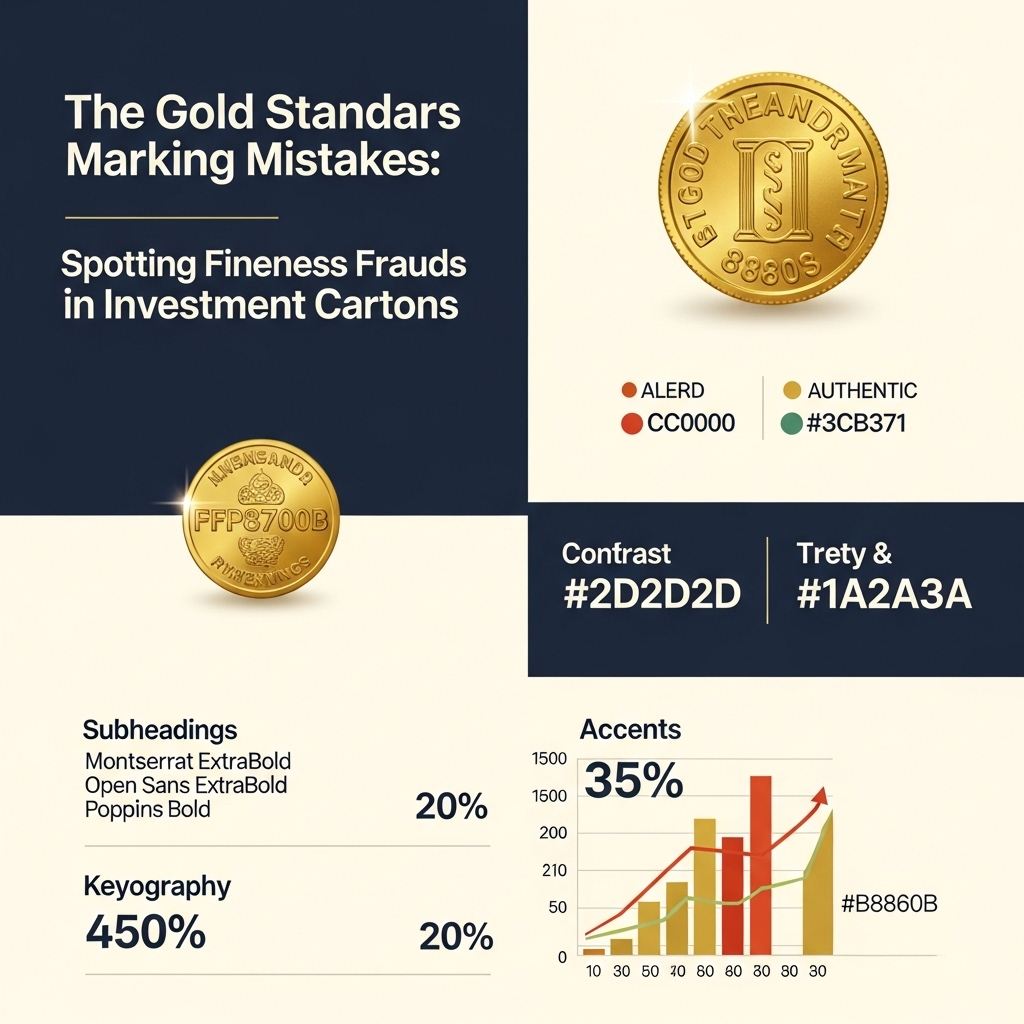Safeguarding Your Golden Investment: Unmasking Fineness Fraud in Cartons
With global economic uncertainties persisting and inflation anxieties on the rise, gold has once again demonstrated its unwavering appeal as a safe-haven asset. We’ve seen its price ascend steadily, drawing in both seasoned investors and new entrants eager to preserve and grow their wealth. This robust market performance underscores gold’s critical role in diversified portfolios, offering both stability and potential for significant financial appreciation. However, as the allure of gold intensifies, so too does the sophistication of those attempting to dilute its true value through deceptive practices.
This very real threat brings us to a crucial, yet often overlooked, aspect of gold investing: validating the authenticity and purity of your physical gold. Specifically, we’re diving deep into ‘Gold Fineness Marking Mistakes: How to Spot Frauds in Cartons.’ This post isn’t just about identifying technical errors; it’s about protecting your financial future. When you invest in gold, you expect a certain level of purity – its fineness – which directly dictates its market value. A mis-marked or fraudulent fineness stamp can turn a seemingly sound investment into a substantial loss, eroding your capital and undermining your portfolio’s integrity.
In a booming gold market, where every dollar invested counts, understanding the nuances of fineness markings, especially on gold bars or coins packaged in cartons, becomes paramount. Fraudsters often capitalize on common packaging and marking discrepancies, making it difficult for the untrained eye to distinguish genuine articles from sophisticated fakes. This guide will equip you with essential knowledge to identify suspicious fineness markings, understand typical fraud methods, and apply practical checks to ensure your gold is indeed 24K, 22K, or whatever purity it claims to be. By becoming savvier in this area, you’ll safeguard your investments against costly deceptions and ensure you truly benefit from gold’s enduring value.
Gold Market Analysis and Key Insights
Gold has historically served as a critical component of diversified investment portfolios, particularly appealing during periods of economic uncertainty and market volatility. Understanding its role is key for any investor.
Gold as a Safe-Haven Asset
Its intrinsic value and perceived stability make it a preferred asset during geopolitical tensions or economic crises. Investors often flock to gold when other traditional assets become unpredictable, leading to price appreciation and capital preservation.
Inflation Hedge
As fiat currencies can lose purchasing power due to inflation, gold often maintains or even increases its value, effectively preserving wealth over the long term. This makes it a crucial tool for protecting against rising living costs and currency debasement.
Portfolio Diversification
Including gold in an investment portfolio can significantly reduce overall risk due to its low correlation with traditional assets like stocks and bonds. It acts as a counterbalance, helping to smooth out returns and provide stability during downturns in other market segments.
Current gold market trends show significant upward momentum, with prices recently reaching or hovering near all-time highs. This surge is primarily driven by persistent global inflation concerns, ongoing geopolitical instability, robust central bank buying, and fluctuating interest rate expectations. Data indicates continued strong investor interest in physical gold and gold-backed exchange-traded funds (ETFs).
For investors, gold offers unique benefits, including remarkable liquidity and a proven track record of long-term value preservation. However, a critical consideration, especially when dealing with physical gold bars or coins, is the pervasive risk of fraud, particularly concerning inaccurate or misleading fineness markings on packaging. Solely relying on external carton markings without thorough verification is a significant oversight that can lead to substantial losses.
Expert recommendations emphasize a prudent approach to gold investment. Investors should typically allocate a modest portion, often 5-15%, of their total portfolio to gold, depending on their risk tolerance and investment objectives. Crucially, always ensure rigorous due diligence: purchase exclusively from highly reputable dealers, demand official assay certificates, and consider independent third-party verification of fineness. Never assume carton markings are inherently accurate; independent verification is paramount to protect against counterfeit or debased gold.

Gold Investment Strategies and Options
Gold remains a cornerstone for portfolio diversification, acting as a hedge against inflation and economic uncertainty. When considering investment, understanding various avenues is crucial, especially given the potential for fineness marking mistakes and outright fraud discussed previously.
Physical Gold: Directly owning coins or bars offers tangible security and a direct hedge against fiat currency devaluation. However, this demands secure storage, insurance, and careful verification of authenticity—the core theme of this book. While providing absolute ownership, liquidity can be lower, and premiums higher, compared to other methods.
Paper/Digital Gold: Exchange-Traded Funds (ETFs) like GLD or IAU provide liquid, cost-effective exposure to gold price movements without physical storage concerns. Gold mining stocks offer leverage to gold prices and potential dividends, though they carry company-specific and operational risks. These options simplify trading but introduce counterparty risk (ETFs) or business risk (stocks).
Risk Assessment & Portfolio Allocation: Gold typically comprises 5-15% of a diversified portfolio, depending on individual risk tolerance and economic outlook. It’s an asset for wealth preservation, not aggressive growth. Avoid over-allocation, as gold can be volatile and does not yield income.
Market Timing: While challenging, gold often performs well during periods of high inflation, low interest rates, and geopolitical instability. Observing macroeconomic indicators, currency strength, and real interest rates can inform decisions. Dollar-cost averaging—investing a fixed amount regularly—mitigates timing risks.
Comparison: Physical gold offers direct ownership and long-term security, ideal for a buy and hold strategy, but requires vigilance against fraud. ETFs and stocks provide liquidity and convenience, suitable for active investors or smaller allocations. Selecting the right method depends on your objectives, risk appetite, and capacity for due diligence.
Market Performance and Outlook
Historically, the market for fraud detection in precious metals has surged during periods of economic instability. Following the 2008 financial crisis and more recently amidst global inflationary pressures, gold’s allure as a safe-haven asset intensified, creating fertile ground for sophisticated fraudsters. This rise in consumer interest, coupled with proliferating online gold sales where physical inspection is limited, propelled the demand for actionable guides like ‘Gold Fineness Marking Mistakes’.
Currently, gold prices remain elevated and volatile, driven by persistent inflation, fluctuating interest rates, and geopolitical tensions. This environment makes robust fraud detection critical, positioning the book as an essential resource for all buyers. The ongoing shift towards digital commerce further amplifies the need for consumers to understand subtle indicators of counterfeiting, even from carton markings.
Looking ahead, economic uncertainties are predicted to continue supporting gold’s appeal. As digital transactions for valuable goods become ubiquitous, the guide’s techniques for identifying fraud without direct physical access will remain invaluable. The future outlook for such specialized knowledge is strong, ensuring sustained relevance as long as gold remains a coveted asset and fraudsters adapt their methods.
Frequently Asked Questions About Gold Investment
Why is carton marking accuracy critical for gold investors?
Carton markings, detailing gold fineness (e.g., 999.9) and weight, are the primary visual assurance of a product’s value and authenticity. Inaccurate or fraudulent markings can lead to substantial financial loss, as the actual gold content might be significantly less than declared, directly impacting your investment’s worth.
What common fineness marking errors or fraudulent practices occur on gold cartons?
These often include deliberate overstatement of purity, misprinted fineness (e.g., 999 instead of 999.9), use of unauthorized or outdated refiner logos, and overall poor print quality. Some schemes involve using legitimate-looking cartons for impure or even plated gold products.
How can an investor verify the authenticity of gold fineness markings on a carton?
Cross-reference the markings with the refiner’s official website, checking specific logos, fonts, and serial numbering conventions. Purchasing from reputable dealers who provide official assay certificates or offer third-party testing services adds a crucial layer of verification.
What are the key red flags to look for when inspecting gold carton markings?
Beware of inconsistencies in font, color, or alignment. Blurry prints, misspellings, unlisted refiner names, or serial numbers that don’t match accompanying documentation are major warning signs. Also, any discrepancy between carton markings and the actual gold item’s engravings is a critical red flag.
Should I trust a gold product solely based on its carton markings?
No. While important, carton markings are just an initial indicator. Always ensure gold products are sourced from trusted dealers, demand official assay certificates, and consider independent third-party testing for high-value investments. Physical inspection of the gold item itself remains crucial for comprehensive due diligence.

Final Thoughts on Gold Investment
We’ve underscored the critical importance of scrutinizing gold fineness markings, particularly on product cartons. Remember, subtle discrepancies, poor print quality, or unusual placement are all potential red flags signaling fraud. Your vigilance and understanding of these common mistakes are your primary defense against counterfeits.
Never solely trust the packaging; the gold itself is what holds value. Our final investment recommendation is to always purchase from highly reputable, certified dealers and strongly consider independent assays for any significant gold acquisition. Gold remains a cornerstone of a resilient portfolio, but its security is rooted in its verified authenticity. Empower yourself with knowledge, stay vigilant, and share your insights to protect your precious metal investments.